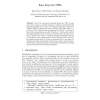Free Online Productivity Tools
i2Speak
i2Symbol
i2OCR
iTex2Img
iWeb2Print
iWeb2Shot
i2Type
iPdf2Split
iPdf2Merge
i2Bopomofo
i2Arabic
i2Style
i2Image
i2PDF
iLatex2Rtf
Sci2ools
OWLED
2008
2008
Easy Keys for OWL
One of the commonly requested features for OWL is some form of key support, generally phrased as allowing inverse-functional datatype properties. For a variety of technical reasons, these were not included in OWL DL (though they were available in OWL Full). OWL 2--a revision to OWL which is under development by the W3C--introduces a form of key representation, so-called "Easy Keys", which avoids much of the implementational pain of general inverse-functional datatype properties, "dumbs down" nicely to weaker languages (like RDFS), and can be specified (or even implemented) in terms of DL-safe rules. The Easy Key approach also allows for a form of compound key. In this paper we explicate the design and rationale of Easy Keys, sketch a decision procedure for them, and compare them with alternative possibilities, including general inverse-functional datatype properties.
Easy Keys | General Inverse-functional Datatype | Inverse-functional Datatype Properties | Natural Language Processing | OWLED 2008 |
| Added | 30 Oct 2010 |
| Updated | 30 Oct 2010 |
| Type | Conference |
| Year | 2008 |
| Where | OWLED |
| Authors | Bijan Parsia, Ulrike Sattler, Thomas Schneider 0002 |
Comments (0)

